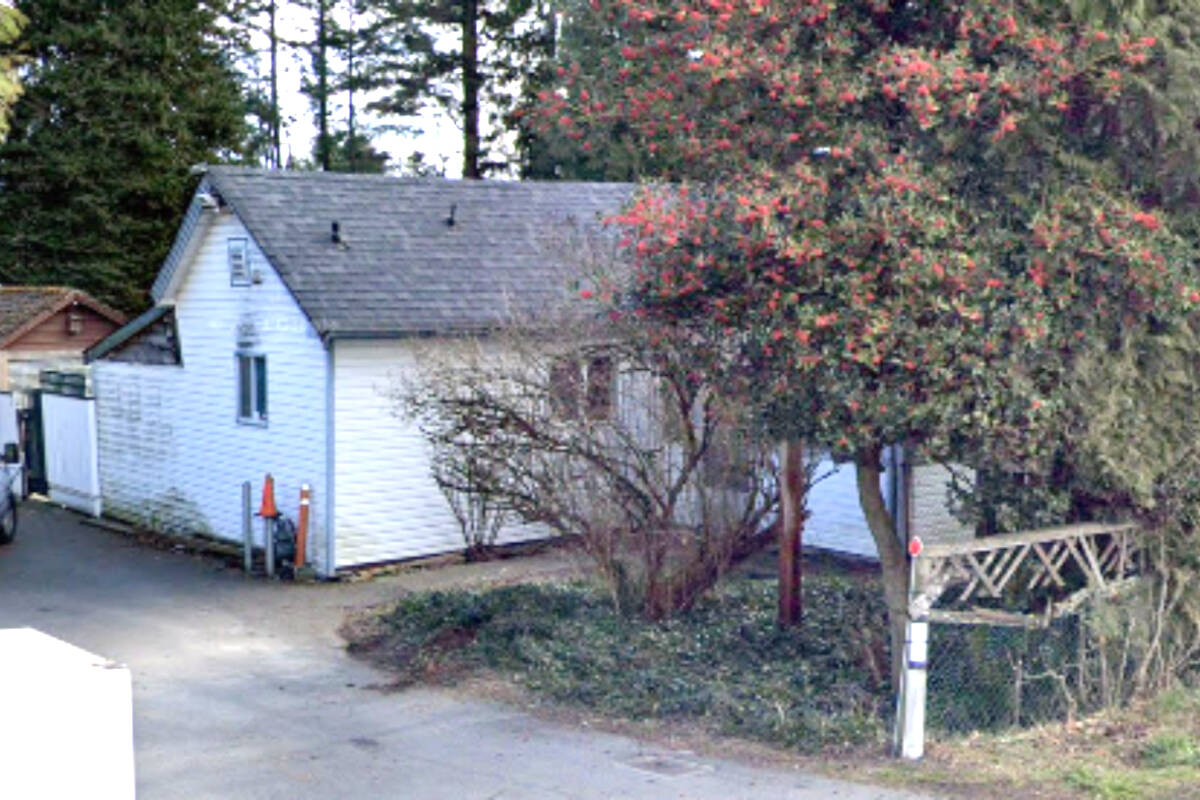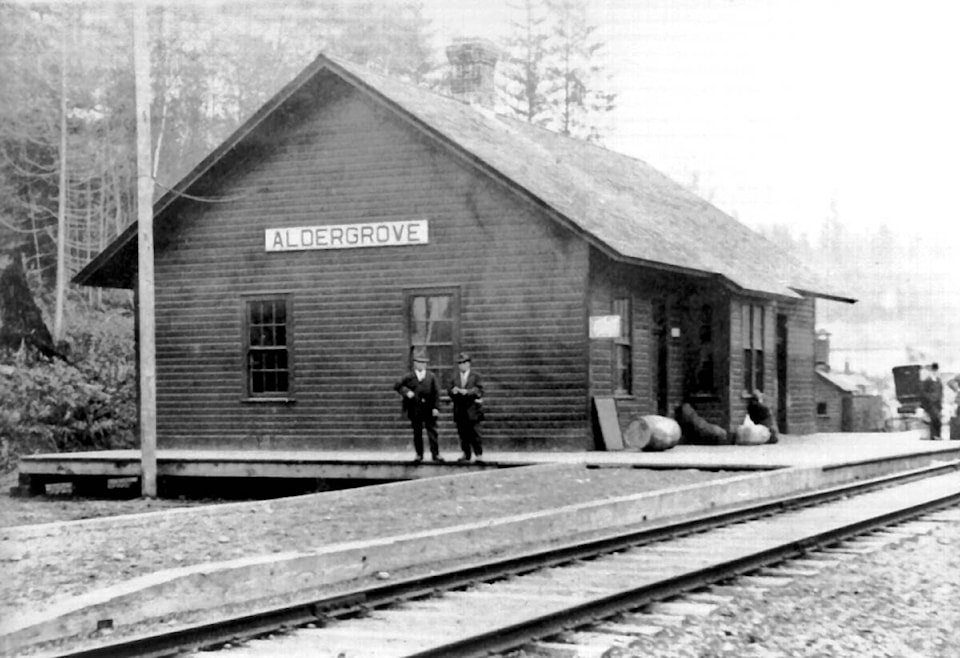By Frank Bucholtz/Special to Aldergrove Star
Transportation corridors are critical elements in moving goods and people, and play a significant role in shaping communities.
In the case of Aldergrove, the most important transportation corridor during the early years of the 20th century was the railway.
This may come as a surprise to many current residents, as there is virtually no trace of any rail line today, other than a few street names – notably Station Road.
The rail line, which operated in Aldergrove from 1909 to 1929, was the Vancouver, Victoria and Eastern (VV&E), a B.C. subsidiary of the Great Northern Railway, based in St. Paul, Minn., and headed by James J. Hill, a Canadian ex-patriate who played a key role in transportation in Western Canada and the western U.S. for more than 50 years.
MORE LOCAL HISTORY – The bare truth: A look into Aldergrove’s former nudist club
He was one of the most important business people in the U.S., due to his control of many key railways – which played an outsized role in the economy at a time when other land transportation was primitive at best, and air transport was non-existent.
Why did he set his sights on the Fraser Valley in B.C.?
It was one small part of a much bigger idea – to link the important mines of the Kootenay region with the B.C. Coast, as well as with the ports of Seattle and Tacoma and the mining centre of Spokane.
There was also an element of revenge.
Hill had been one of the original partners in the Canadian Pacific Railway, but left the company when his chosen general manager, William Van Horne, insisted on an all-Canadian route between Ontario and the western provinces.
Hill had pushed for the CPR to link with his railways in Minnesota and reach Winnipeg through the United States.
Van Horne became the CPR president in 1888, and he and Hill battled for control over various routes for the next 20 years or so.
While the battle was over money, there was a strong personal element to it, as well.
Hill’s Great Northern had reached the West Coast in 1893 and played a huge role in the development of Seattle.
It also went through Spokane, which was already a bustling mining centre thanks to rich ore discoveries in the Coeur d’Alene area of Idaho and in the Kootenays.
When the CPR proposed to build a railway linking the Kootenays with Vancouver, Hill fought back with a plan to move traffic between the Kootenays and the West Coast via the VV&E and a Washington State subsidiary, the Washington and Great Northern.
His rail line dipped back and forth across the Canada-U.S. border, which Hill barely paid attention to.
He was an early believer in free trade, and felt the differences between the two countries were insignificant.
His first foray into B.C. was the New Westminster Southern, which in 1891 crossed the border near the current Pacific Highway crossing in Surrey.
Its modern-day successor, Burlington Northern Santa Fe, remains an important link between the Vancouver region and the U.S. today.
Another early Hill-owned line ran between Spokane and Nelson, and served as an important feeder to the GN mainline. It was operating by 1893, long before CP made its way to the Kootenays.
By the early 1900s, railway fever was intense in B.C., and was a dominant political issue.
Hill saw an advantage in extending the GN from its B.C. bases of Nelson and Vancouver to all points in between. There was no shortage of traffic possibilities.
The VV&E charter allowed the GN to build through the Fraser Valley to Hope, and in 1908, its line was built to Aldergrove from the west.
The line opened in 1909.
Even before it was complete, a shingle mill had been located in Aldergrove in anticipation of being able to ship its product by rail.
Aldergrove was already an established community, because of the Yale Road, although it was small and predominantly rural.
The logging industry in the area grew rapidly after the rail line opened, and the railway offered faster and more comfortable transportation for passengers.
It also transported express mail, and many other commodities, including supplies for farmers and local businesses.
VIDEO – From the attic to online: how the Alder Grove Heritage Society is digitizing history
One current Aldergrove building that was almost certainly transported by the GN is the former B.C. Telephone office, now the Aldergrove museum at 271st Street and 32nd Avenue. It is an early-day modular building, and was assembled at its destination. It has been moved several times through the past 100 years.
Passenger service was never particularly speedy or bountiful.
At first, there were mixed freight and passenger trains between Sumas and Vancouver three times a week.
By March 1910, this service had increased to daily, except Sundays.
In 1916, a daily mixed train between Vancouver and Hope was established, as part of the GN’s goal to have service all the way to the Kootenays.
The train to Hope only lasted until 1919. The GN plans to offer through service to the Kootenays never came about.
The remaining mining business there was largely under control of Cominco, owned by CP.
After that, a daily except Sunday mixed train between Port Guichon (near Ladner) to Sumas started.
Service was reduced to three times a week in 1924 and ended altogether in 1929.
The tracks remained in place until 1934.
Freight shipments, particularly those from the forest industry, had declined. This was due to better roads (a portion of Yale Road was paved in 1922, and more paving followed).
A new, more direct road now known as Fraser Highway opened in the early 1930s.
Other transportation options became more viable.
The GN applied to close the Aldergrove station in 1925, but this was rejected by the federal government, after loud protests from Aldergrove residents.
The station closed and telegraph service ceased in 1929, when the last train ran.
The station building stood for many more years.
There were also a number of railway outbuildings on or near Station Road, which stood for many years.
Conflicting reports about the station make it unclear exactly what happened to the building. One report says it was moved to a site on Fraser Highway just east of the town centre, while another says it was dismantled and the lumber used to build a new building at Lefeuvre Road and Fraser Highway.
It is possible that both reports are accurate, given that there was more than one building at the station site.

Another residence owned by the railway was lived in by the Lundeberg family. It stood at 2774 Station Rd.
Intensive residential development in the area where the GN buildings and tracks were means there is no trace left today. However, many street names in the area have railway themes, such as Roundhouse Drive, Whistle Drive, and Caboose Place.
The availability of rail transport definitely helped Aldergrove to grow significantly in the early years.
EDITOR’S NOTE: Much of the material contained in this story was gathered by Ken Atkey, who wrote a history of the GN in Aldergrove, which was published in 2005. The pamphlet is available at the Aldergrove Museum.
.
Have a story tip? Email: roxanne.hooper@langleyadvancetimes.com
Like us on Facebook and follow us on Twitter.
